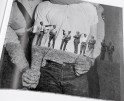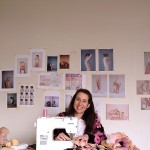Photography + Form Week: Danielle Andress
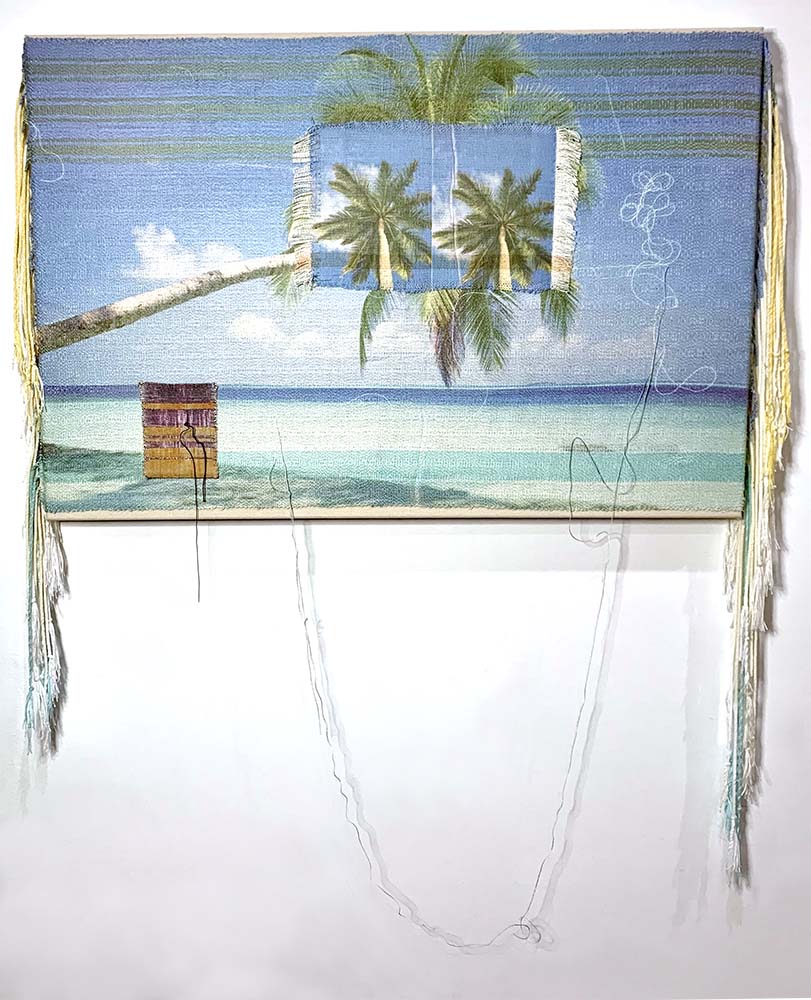
©Danielle Andress, three palms, handwoven polyester with dye sublimation printing, handwoven cotton and polyester swatch on stretched canvas 2022 36” x 24”
Photography is my first love, but at times I feel that it falls flat for me (how ironic) and I seek out other ways that may tell the story more effectively. While researching for my own photo based projects, I often come across the work of others who push the medium far into new corners through the use of textiles, thread and sculptural elements or any combination thereof. Due to the saturation of images, it seems that some artists have been less inclined to use photography as a language but rather as a form to recreate objects such as textiles, 3-dimensions or a combination of both. The artists featured this week are all inspired by imagery or choose to create sculptural elements with in their imagery to create a layered investigation of their worlds. – Maggie Meiners
Danielle Andress produces non-functional weavings and assemblages that investigate our relationships with consumable images, siloed spheres of influence, the circulation of information, and irregularities of language structures through the poetics of weaving and everyday objects. I chose to feature Danielle’s work as I thought her methods and use of material being inspired by image culture was an interesting way to interpret the current image climate. I’m thrilled Danielle is one of Chicago’s own and have really enjoyed learning more about her work and hope to do a studio visit sometime in the near future.
Danielle Andress is a Chicago based artist and educator. She primarily produces non-functional weavings and assemblages that investigate our relationships with consumable images, siloed spheres of influence, the circulation of information, and irregularities of language structures through the poetics of weaving and everyday objects. Working from crowd sourced image collections, the work literally weaves together divergent perspectives as an act of equalization and radical reconstruction. As a bi-racial practitioner, her work explores identity politics via slow craft and material artifacts through a multicultural lens. Her work engages mass media spectacles especially serial television, viral moments, and social media. She earned her BFA from the Rhode Island School of Design and an MFA from the California College of the Arts. Danielle Andress is an Assistant Professor at the School of the Art Institute of Chicago in the Fiber and Material Studies department where she teaches hand and digital weaving. She has exhibited widely both nationally and internationally. She lives on the southside of Chicago (it’s the closest to the west coast the Midwest will ever get) with her husband, kid, and dog.
Follow Danielle Andress on Instagram: @danielle_andress
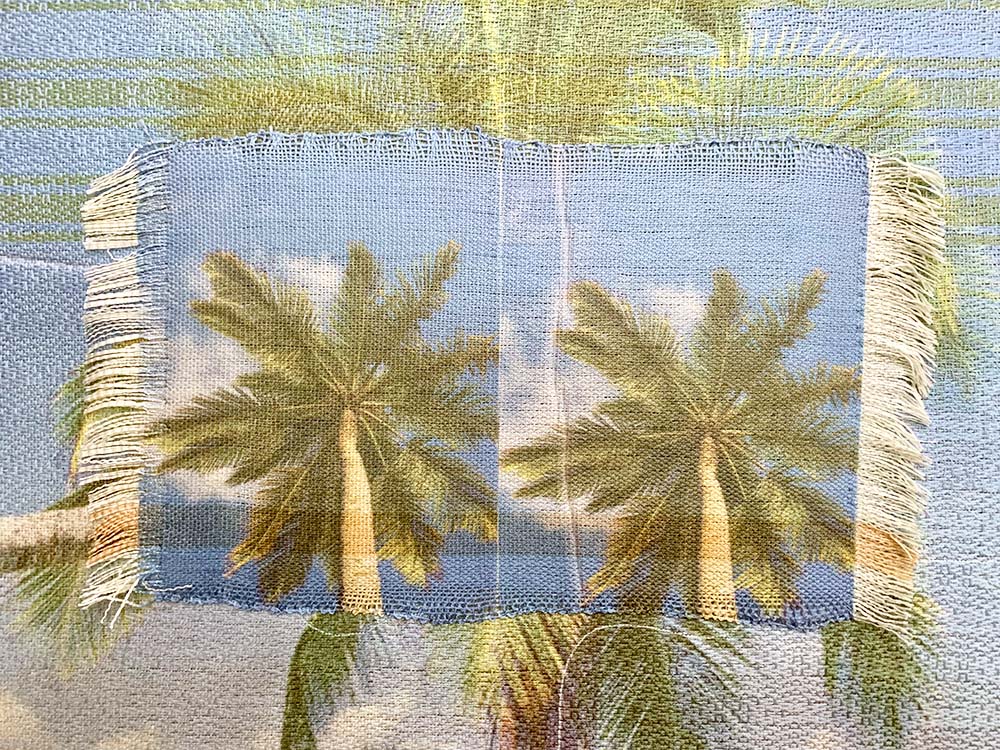
©Danielle Andress, three palms (detail), handwoven polyester with dye sublimation printing, handwoven cotton and polyester swatch on stretched canvas 2022 36” x 24”
Coming of age in the 1990’s means I have experienced pre and post internet life. I can nimbly toe the line between outrage and complacency about its impact in bringing on the demise of civility, patience, and critical thinking. I know how to be bored but that does not mean I want to be. I am interested in how images and ideas circulate in physical and digital spaces and how these differences can be used to challenge and explore the other. Using largely appropriated photographs scraped from digital crowd-sourced databases, utilitarian materials, and found objects I construct physical manifestations of things that were once immaterial. My work is fueled by the endless scroll on the internet, the limitlessness of digital landscapes, and a flirtatious attraction to failure. Using the language of weaving the work expands upon the immediacy and complexities of contemporary human connectivity. I metabolize rapidly changing ideas, trends, and popular culture through slow craft and material specificity. As a practiced weaver, my work brings together divergent perspectives, incongruent objects, and tightly curated images through the architecture of woven cloth and the banal experience of the everyday. Weaving and the internet have a shared lineage, root structure, and the awesome capability of collapsing time and space. By prioritizing the idiosyncratic behaviors of the raw materials, the structure of woven cloth functions as a rich metaphor for identity politics, life cycles, and parallel existences. It’s a battlefield for visibility, of form versus function, an inhospitably liminal space.
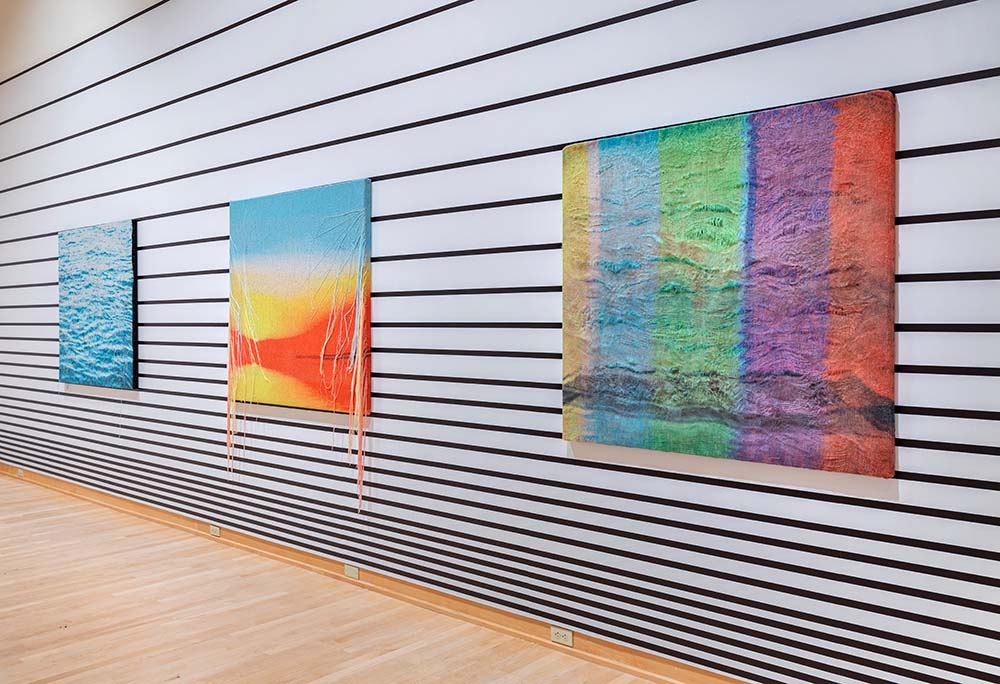
©Danielle Andress, rubbed triptych, Jacquard woven cotton, rayon, and polyester with dye sublimation printing on stretched canvas. Weavings are hung on custom wallpaper (John Michael Kohler Art Center) 2021 dimensions variable. Each weaving is 54” x 48”
Tell us about the landscape of your childhood and how you came to be an artist.
My dad served 23 years in the US Army so growing up, we never spent more than 4 years in one place – Alaska, Washington, Germany, South Korea, with stints (1-4 months) in Hawaii and China. One summer we spent the entire three months slowly driving across the country, living in a dusty, lemon yellow Volkswagen camper van – six people and two cats. My parents are artists in their own rights: my dad tinkers in wood and metal and my mom is a cellist. Although they still question the viability of my career path as an artist, they’ve always been super supportive. I am the third daughter in a family of four kids (the fourth being a boy) with an immigrant mom from North Korea and a dad hailing from Oak Ridge, Tennessee. I was pushed into music early on and survived 7 years of piano lessons from about age 6. I think my mom is still disappointed that it didn’t pan out. My last piano teacher told me I wasn’t any good because I was always distracted with what was happening and therefore was never ready for what was next. The music always got ahead of me. I was never any good and by the end didn’t care about being terrible but what stuck with me was the power and command a really, really talented musician could have on an audience. That’s what I remember and that’s what I was after. I felt like I had something to say but lacked the language or skills to get it out.
I jokingly describe myself as an “elder millennial” and that I’m part of a really lucky subset of a generation whose formidable years include pre and post internet experiences. This isn’t necessarily responsible for me becoming an artist but it certainly has impacted my worldview and understanding of the internet as a space for research, engagement, and artistic opportunities. Artists are charged with responding to the contemporary human condition through cultural output and it’s impossible to ignore the continual impacts of the internet, good and evil. When I was growing up, the internet offered a window into a world I felt I was missing out on living as a mixed-race kid in a largely homogenous suburban hell. Fellow members of this unique cohort have a lot of wisdom to share.
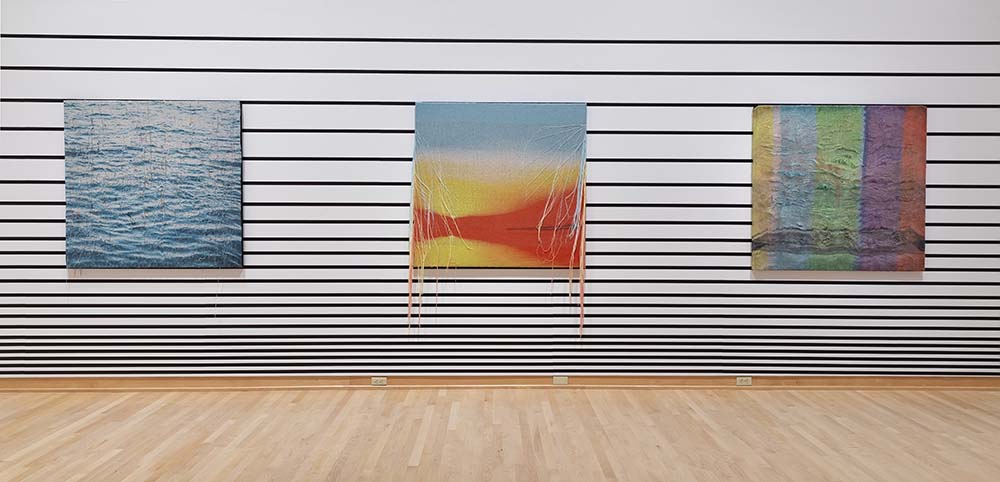
©Danielle Andress, rubbed triptych (side), Jacquard woven cotton, rayon, and polyester with dye sublimation printing on stretched canvas. Weavings are hung on custom wallpaper (John Michael Kohler Art Center) 2021 dimensions variable. Each weaving is 54” x 48”
What was your first meaningful encounter with art ?
My coming of age happened in the nineties – early internet, BMG music CD subscriptions, and mall bookstores. I found a coffee table book of Dalí paintings at a Barnes and Noble that completely blew my mind. I still love Dalí and had the privilege of seeing the huge show at the Philadelphia Museum of Art in 2005 but falling in love with his work at a young age is comparable to being a New York Yankees or Dallas Cowboys fan when you’re a kid. If you’re my age and grew up in the Michael Jordan era, loving Dalí is like loving the Chicago Bulls – which I still do. Dalí was radical and uncanny in a way that I had never seen before. It was sexy and gross and it made me hungry and also made me want to take a shower. My freshman year of college, I made an embarrassingly sincere zine titled something like “lobster + telephone” in homage to Dalí. Compounded with his immense success and that fact that so many people supported his arguably poor behavior added to my intrigue.
Less directly, getting our first home computer also had a tremendous impact on me. We were living in Korea at the time and my dad, a self-described luddite, brought home a Dell that we primarily used to play Minesweeper. Soon after we got a clunky video editing “game” that essentially let you drag clip art icons around the screen to 30 second looped songs. Even then, all of us kids knew it was awful for what it was but we loved it. We would host semi-regular film festivals and proudly premiered our movies. A little bit later, I was identified as having an “artistic talent” by my computer teacher for some digital collages I made. Basically I made something my teacher had never seen because I was using the tools the wrong way, creating fields of color and texture by painting with single motif stamps and tiling out unusual tessellations. I thought I was in trouble because the teacher took me to the principal’s office to show him what I had done.

©Danielle Andress, rubbed water, Jacquard woven cotton, rayon, and polyester with dye sublimation printing on stretched canvas. 2021 54” x 48”
How does photography influence/inform this body of work and vice versa ?
A majority of the photographs and images I use are stock images, scraped from the internet, or are relentlessly scrolling in front of me via advertisements and social media posts. I look to photography as a medium for its immediacy and perceived authenticity. It’s often fast and efficient and that sets up a nice dichotomy with weaving which is notoriously slow and labor intensive. I like the idea of materializing the digital and the differences in understanding between images and objects and when images become objects. Because I’m primarily using pre-existing photographs in my work I’m at the mercy of what’s being circulated or available. I’m expanding into video and projection and realizing I need to take a photography class.
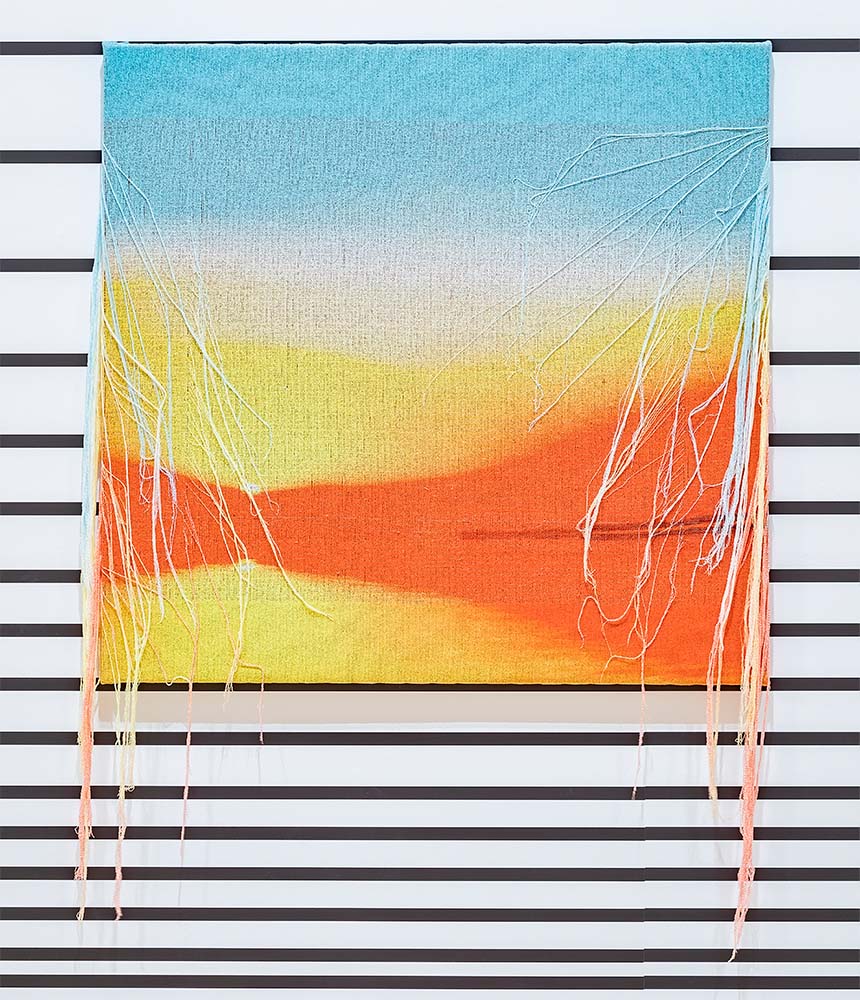
©Danielle Andress_rubbed sunset Jacquard woven cotton, rayon, and polyester with dye sublimation printing on stretched canvas. 2021 54” x 48”
How does photography integrate into your current medium ? Or if you are still using photography how does it relate to the other materials that you are using ?
I’m really interested in how images circulate, particularly through digital channels like social media and crowd sourced collections and search engines. When I was in college, the internet was blooming and the transition from analog to digital was ramping up across campus. However, the school firmly held onto their “image collection” which was a large room carved into the main library. It was curiously huge, with long tables, and a big window where work study students and one librarian sat. Behind them were rows and rows of metal filing cabinets. In those filing cabinets were deep pocketed folders full of laminated images consisting mostly of magazine clippings and printed advertisements with benign labels like “horses” and “cakes.” This was an art school and students would check out pertinent folders from the image collection for research because the ubiquity of Google wasn’t what it is today. This was pre-smartphone. The most interesting part about the image collection was the curation and maintenance of the folders. The straightforward folders with categorical titles like “sunsets” and “vintage cars” were filled with the expected but any of the more subjective folders like “happy birthday” or “homosexual” were curated strictly by the image collection librarian (and maybe the work study students? I’m not sure who was charged or had the final say in cataloging the images) to place. These were the folders I was the most interested in exploring. I’m still looking for these bizarrely placed images, only I’ve expanded to looking at the internet instead of a room full of filing cabinets. Most of the photographs or digitally constructed images I used are found or appropriated but they all are part of the public domain. I’m not interested in stealing or pirating content, rather I’m focused on what happens when there’s a clear breakdown or alternative possibility created through bringing images together. Going back to my answer about Dalí, maybe I’m still trying to put a lobster on a telephone?
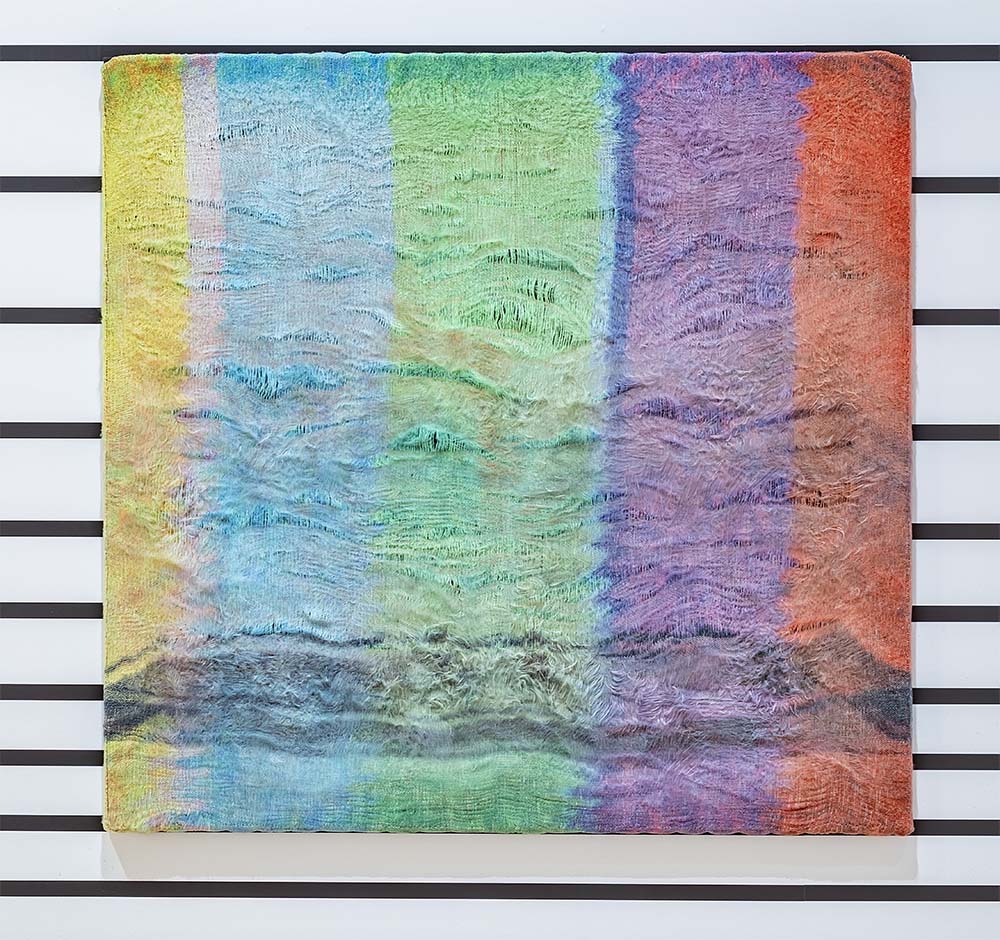
©Danielle Andress, rubbed colorbar, Jacquard woven cotton, rayon, and polyester with dye sublimation printing on stretched canvas. 2021 54” x 48”
What process is used in deciding what material to use when it comes to taking it from straight photography to something of another dimension ?
Working in the language of weaving, I have to be extremely strategic when choosing materials and woven structures. There are limitations to marrying fiber and photography. All of this work incorporates photographic imagery either through Jacquard weaving or through dye sublimation printing. Jacquard weaving debuted in France in the early 1800’s and irreversibly revolutionized woven cloth production. Essentially, this type of weaving allows individual warp threads (the tensioned, vertical component of weaving) to operate individually. Before the Jacquard loom, weavers were limited to lifting groups of warp ends in units via the harnesses on a particular loom. This architecture meant all continuously woven cloth consisted of repeating patterns, even if very intricate (this does not include tapestry weaving). Handweaving on traditional floor looms made complex weaving time consuming and very, very expensive. When Joseph-Marie Jacquard debuted his invention it immediately displaced thousands of professional weavers and draw-boys (the child workers who operated looms with their critically important small hands), pissed off the ultra rich who used finely woven cloth as a status symbol, and lead to some of the first heists of intellectual property when the punch cards that operated the Jacquard looms were routinely stolen from one weaving mill to the next. These looms were the predecessor to all binary languages including the operating systems for player-pianos, analog music boxes, and arguably the architecture of the internet. These are all incredibly fascinating histories with their own rabbit holes to fall into and contribute to my fascination with Jacquard weaving. Fast forward to today, one can plan and execute a non-repeating, photographic weaving in an afternoon using a computer operated Jacquard loom. There are even Jacquard looms designed specifically for artists.
The other technology I rely heavily on is dye sublimation printing. Dye sublimation printing was invented in 1957 by another French inventor, Noel de Plasse. Dye sub, as it’s commonly referred to, became popular in the early 1990’s to cheaply brand products, specifically sports teamwear. Dye sublimation is a process that converts a solid material (the printed image) into a gas and back into a solid (the woven material) through heat and pressure. Dye sublimation only transfers into synthetic materials: plastics, coated metals, chemically treated ceramics, and (most importantly) synthetic fibers like polyester and acrylic – the fibers I often weave with. By strategically using or placing synthetic yarns into a weaving, I can essentially “dodge and burn” where the image will transfer.
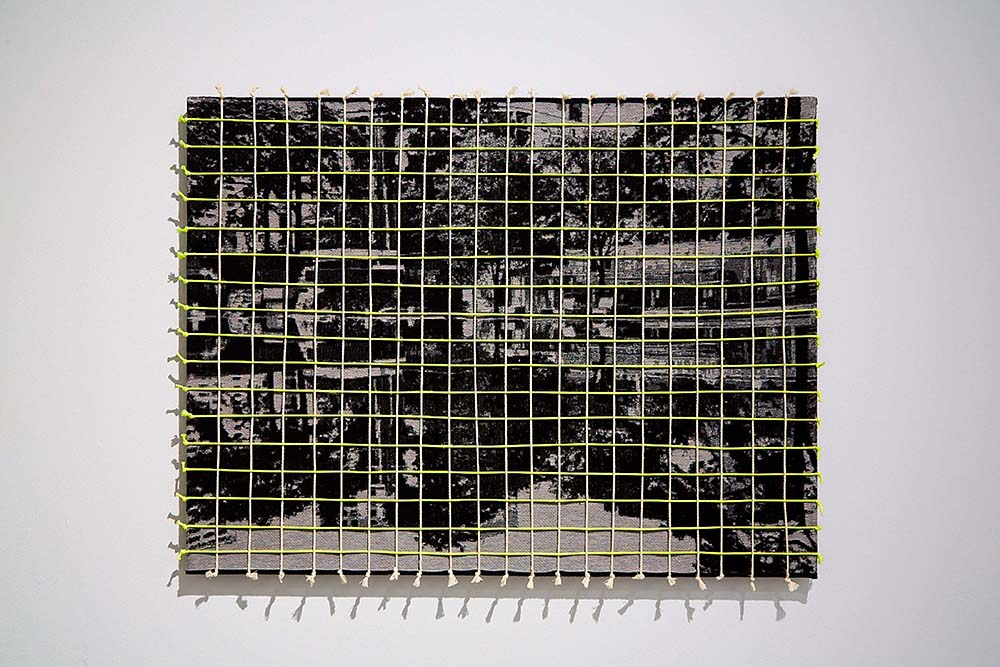
©Danielle Andress, Trick Mirror, Jacquard woven cotton and rayon, paracord, cotton rope, and polyester thread on stretched canvas 2020 46” x 35” x 2.5”
What were you reading, watching or listening to while making this work ? If you don’t remember, can you tell us what pieces of literature, art or film may have helped direct this work ?
I LOVE this question. I’m an insatiable consumer of…many things. It’s difficult to answer as I included work I’ve made over the past 5 years but I’ll do my best to be concise! I’m a religious NPR listener and make time for at least 2 hours of that every day. I love serial television, especially what HBO and Netflix have been putting out in the past couple of years: Insecure, Search Party, The Mitchells v.s. The Machines, South Side, Raised by Wolves. I recently finished The Dropout (Hulu) which was fantastic and I binged the last season of Better Call Saul that Netflix is streaming in 3 days.
Working in a very slow craft, I am also very drawn to stand-up comedy for its immediacy. Comics have the opportunity to metabolis the contemporary experience which I am simultaneously envious of and grateful that I don’t share the same responsibility. I was in grad school during the 2016 election and I vividly remember having a conversation with one of my advisors a couple days after and we both agreed that comedy was about to get really, really good. We were right. I appreciate the increased visibility and space given to diverse voices in stand up these days.
My iPhone has 100% contributed to my attention span getting shorter and I feel like it’s also making me read less (am I alone in this? Is that a cheap excuse? Probably). In the last year the books that have left a lasting impression are Minor Feelings by Cathy Park Hong, No One is Talking About This by Patricia Lockwood, and Overshot: The Political Aesthetics of Woven Textiles from the Antebellum South and Beyond by Susan Falls and Jessica R. Smith. My partner is great at escaping into a book and has a long list of titles for me but I’m not sure where I’ll find the time.
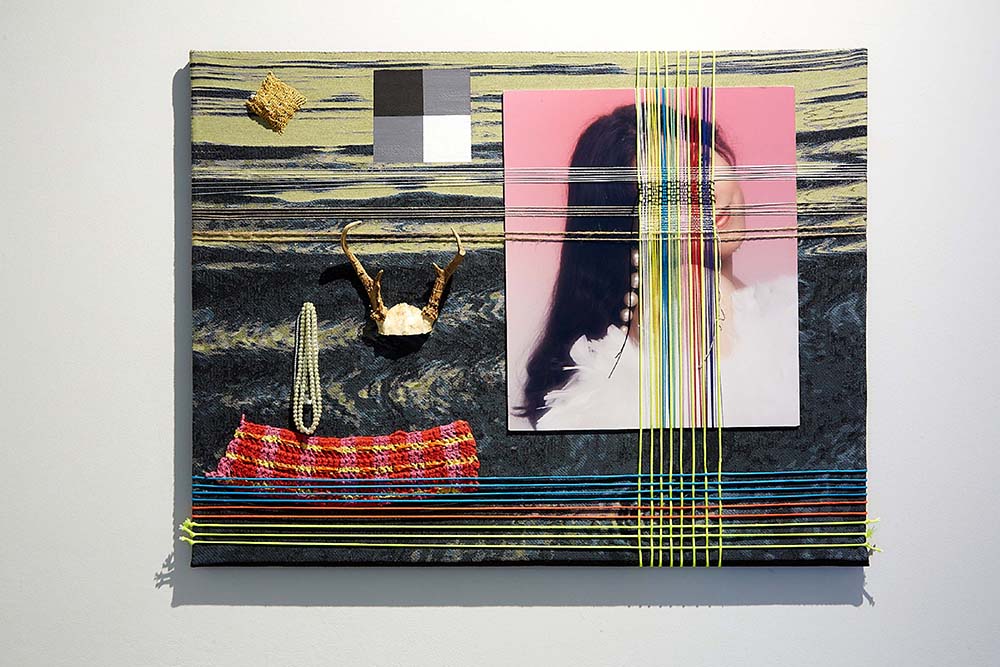
©Danielle Andress, Fake it till You Make it , Jacquard woven cotton and rayon, mounted Glamour Shots photograph (1997), paracord, jute, linen, Jellycord, synthetic yarn, glass beads, acrylic paint, White Tail deer antlers (shot 1976), cotton and polyester thread on stretched canvas 2020 46” x 35” x 7”
What are you working on currently and does it relate to photography, if so, how ?
I am working on a body of work that’s been in progress for about a year now. The planning and execution of a weaving can take months, unless you have studio assistants which I currently do not. No spoilers but it’s a series of hand and digitally woven pieces that look to mediated versions of the natural world as an impenetrable space of possibility. It’s about fantasy and the sublime, and materializing the endless impermanence of the internet through the lazy lens of nostalgia. I’m looking at a lot of beach photography and factory setting desktop screen savers.

©Danielle Andress, 1993, Jacquard woven cotton and polyester with dye sublimation printing, gold tacks, bubble wrap, and acrylic paint on stretched linen 2019 36” x 36”
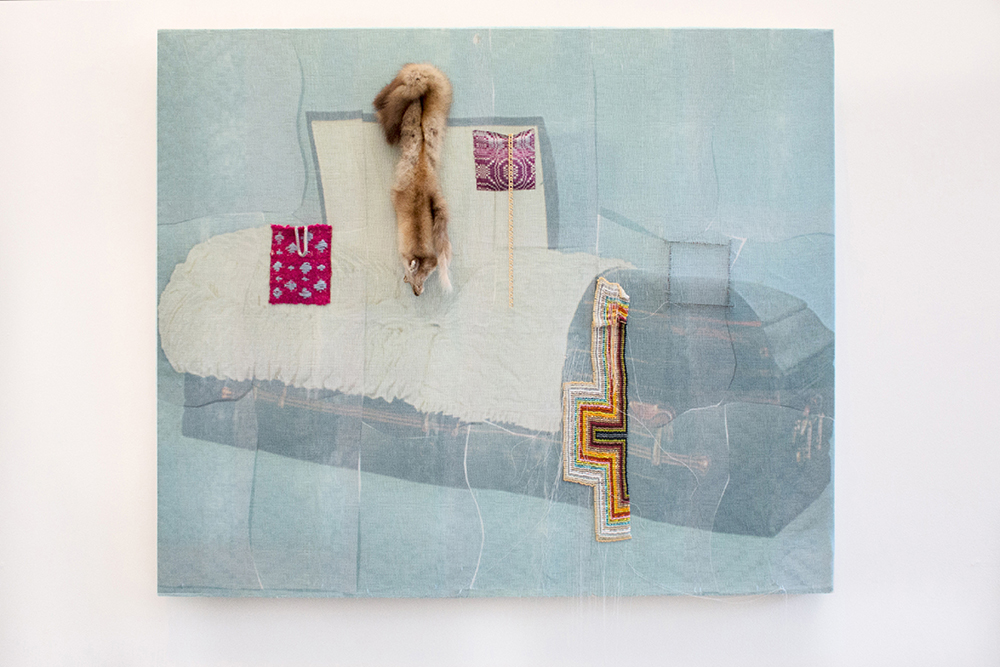
©Danielle Andress, All the Comfort Wood Can Give, handwoven polyester with dye sublimation printing, fur pelt, handwoven cotton swatches, gold chain, silver chain, embedded nail frame loom, and handwoven glass beads on stretched linen 2017 56” x 46”

©Danielle Andress, Fake it till You Make it , Jacquard woven cotton and rayon, mounted Glamour Shots photograph (1997), paracord, jute, linen, Jellycord, synthetic yarn, glass beads, acrylic paint, White Tail deer antlers (shot 1976), cotton and polyester thread on stretched canvas 2020 46” x 35” x 7”
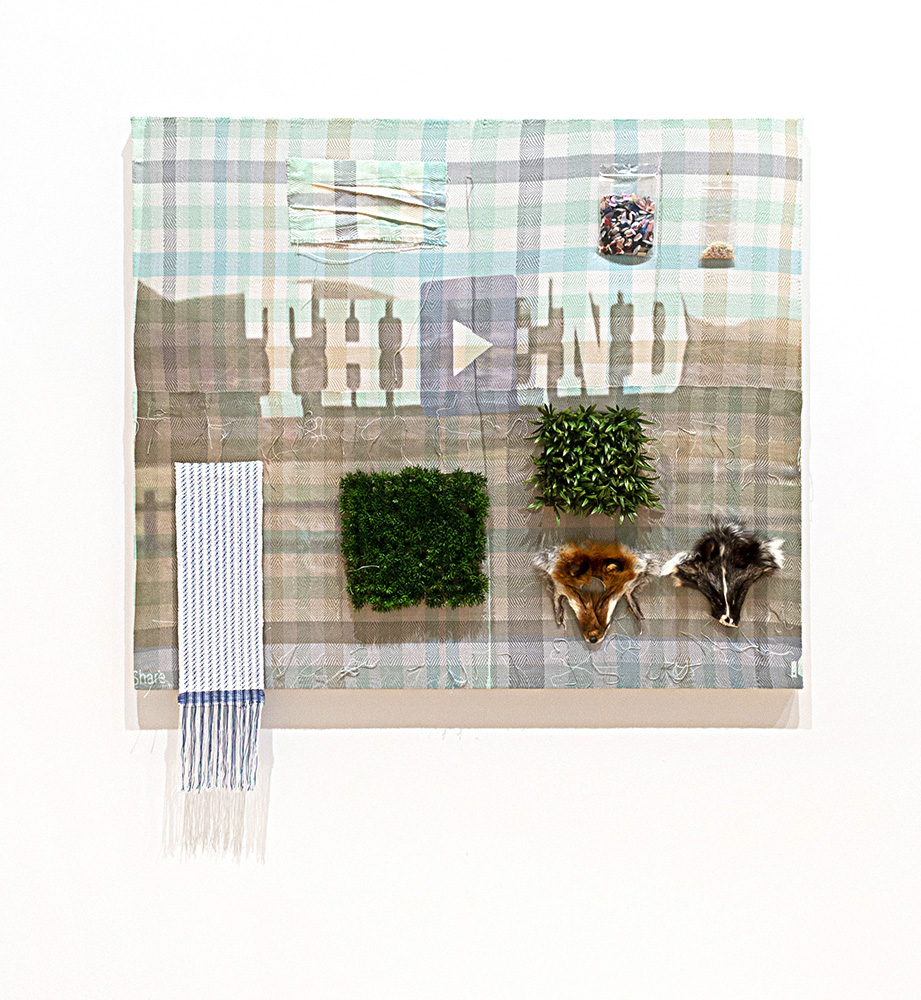
©Danielle Andress, The End, handwoven polyester with dye sublimation printing, artificial grass, fox fur, badger fur (both purchased at the 1987 World Eskimo Indian Olympics), used artificial nails, 1-year of the artist’s nail clippings, plastic bags, cotton and polyester threads, and gold tacks on stretched canvas 2020 – 2021 56” x 48” x 6
Maggie Meiners (b.1972, Chicago) Maggie Meiners is an interdisciplinary artist whose work revolves around self-critique. Heavily influenced by image culture and how it personally affects her, Meiners deftly deploys photography, stock imagery, film stills, cultural artifacts and magazines to tackle subjects such as identity, gender, and social status. Using appropriation, assemblage, film making and installations, Meiners explores the psychological affects of popular imagery on her psyche.
Her interests lie in deconstructing the current cultural narrative as a way of empowerment and defining her personal identity. The internal conflicts that manifest from the constant barrage of the media as well as societal expectations (both self-imposed and external) within the current social construct are also represented in her work. Using these varied modes and mediums, Meiners’ work highlights feminism and contemporary notions of gender, domesticity, beauty, consumption, and body image. Humor and subversive messaging in Meiners’ work is relayed as an abundance of bright, often lurid colors and textures in jarring, frenetic, and imperfectly arranged pieces. Such arrangements evoke the essence of simultaneous desire and absurdity, a psychological manifestation of our culture of perfection and truth.
Maggie’s art has been widely exhibited and remains in the permanent collections of the Illinois Institute of Art, Wheaton College, Harrison Street Lofts, Fragomen, Del Rey, Bernsen & Loewy, LLP and numerous private collections. In addition, her work was on loan at the American Embassy in Uruguay from 2016-2019. Maggie had her first solo exhibition in 2005 at The Union League Club of Chicago– one of the most esteemed private collectors of art in the country and is represented by the Anne Loucks Gallery in Glencoe IL.
Follow Meiners on Instagram: @MaggieMeinersProjects
Posts on Lenscratch may not be reproduced without the permission of the Lenscratch staff and the photographer.
Recommended
-
Ricardo Miguel Hernández: When the memory turns to dust and Beyond PainNovember 28th, 2025
-
Pamela Landau Connolly: Columbus DriveNovember 26th, 2025
-
KELIY ANDERSON-STALEY: Wilderness No longer at the Edge of ThingsNovember 19th, 2025
-
Jackie Mulder: Thought TrailsNovember 18th, 2025
-
Accidental Evidence: Mike Mandel and Chantal ZakariOctober 22nd, 2025





